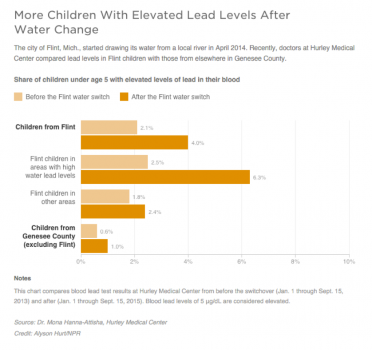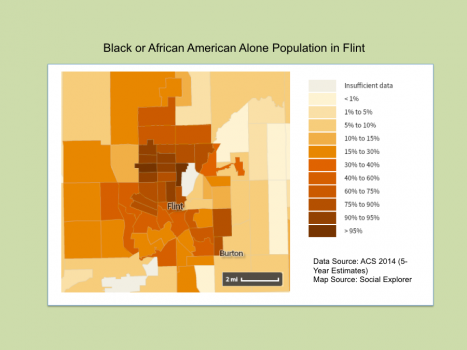By Missy Velez ’16 (Environmental Studies major from Baltimore, MD)
Type the word “Flint” into any news website, from CNN to NPR, and a slew of videos, articles, podcasts, and news clips will immediately populate. Some stories go as far back as October 2015[1], and the most recent have just been posted hours ago[2].
The unfolding story of lead poisoning in Flint, Michigan has been one of the most continuously covered news stories in the past months. In order to save money, Flint stopped drawing water from Detroit’s urban system and instead turned to the Flint River. This water, however, was more corrosive than Detroit’s water due to chemical treatments used to kill E.boli bacteria. This corrosive water deteriorated Flint’s aging pipes, leaching lead into citizen’s tap water.[3]
When viewed from the perspective of the 24-hour news cycle, what is it about this story that has kept the nation’s attention for close to four months? It could be the fact that children’s lives are being threatened by lead poisoning (Fig. 1), or that Flint’s population has higher percentage of Black or African-American citizens (Fig. 2), or that the crisis reveals the unstable infrastructure supporting America’s aging cities.

Fig. 1

Fig. 2
Children are more affected by lead levels because the effects of lead are most apparent in developing bodies and are irreversible. Once the harm is done, it will continue to affect them for the rest of their lives.
Furthermore, Flint’s population has higher percentages of black or African-American citizens than surrounding census tracts in Genesee County. This has raised concerns over environmental justice issues: did historical and contemporary Black and African-American disenfranchisement influence this crisis?
The fact that the “American City” is threatened by aging infrastructure has also been called into play. Established in 1819, Flint rose with the automotive industry, and has been financially and demographically unstable since its demise.[4]
While these causes all come together to attract different interests, ranging from social justice to economics to urbanism, what really involves the media is the universality of the crisis in Flint. We all rely on tap water, and when that source of water is poisoned, we are all reminded of how easily it could happen to us. This then forces us to ask the question of who is responsible for solving this problem. Should Flint citizens not have to pay for their water, even if only some of them are affected? Should Flint be allowed to take water from Detroit’s system for free, because the government never updated the pipes? Who should pay for the ongoing cost of medical treatment for those affected?
Here at Colgate, we use our academic and personal experiences to engage with the ongoing dialogue centered on a range of social justice issues. We should do the same with environmental issues, which more often than not, directly engage with issues of social injustice. Flint demonstrates this relationship very clearly, and its complex nature is perhaps why it has retained ongoing media attention for so long.
[1] http://www.npr.org/2015/10/05/445975954/elevated-lead-levels-detected-in-some-michigan-childrens-blood
[2] http://michiganradio.org/post/new-tests-show-some-homes-flint-have-lead-levels-10x-federal-action-limit
[3] http://www.npr.org/2015/10/05/445975954/elevated-lead-levels-detected-in-some-michigan-childrens-blood

